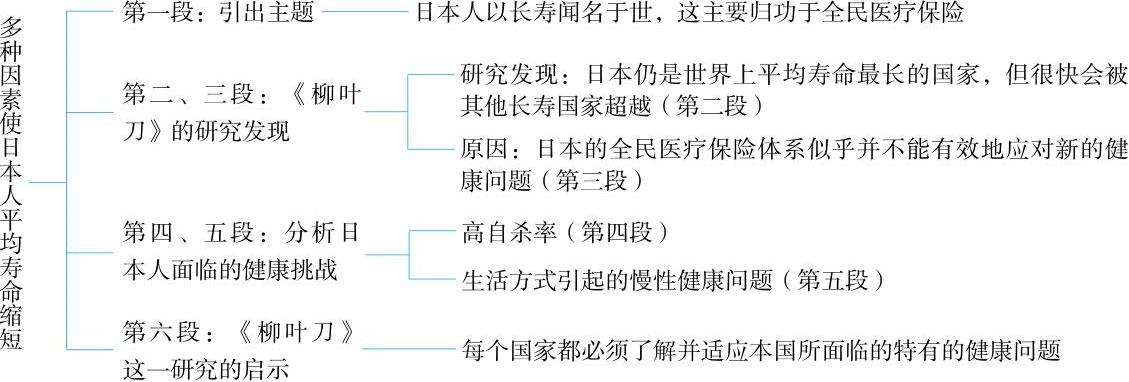




Beginning in the 1950s and 1960s, Japan began developing a reputation for its longevity. By the 1970s, the Japanese were the longest lived of any population in the world. Although genetic predispositions and cultural factors like diet certainly contributed to the long life span of the Japanese, it was the country's kaihoken, or universal health care, that was largely responsible for boosting quality of life and increasing the country's life expectancy.
In recognition of 50 years of kaihoken , the medical journal Lancet recently published a special issue exploring Japanese longevity. Unfortunately, it's not all good news. Even though Japan continues to have the highest life expectancy in the world, it is on track to be outpaced by other long-lived countries, like Sweden (which has high male and female life expectancy) and Italy and Australia (with high male life expectancy). Researchers believe that relatively high rates tobacco use, changes in diet that have raised body-mass index, and the rising rate of suicide are contributing to Japan's slowing declines in rates of adult mortality.
“If recent trends continue, other nations are likely to achieve lower rates of adult mortality than Japan,” said Professor Christopher Murray of the Institute for Health Metrics and Evaluation, University of Washington. He added that Japan's universal health care system may not be sufficiently nimble enough to address mounting 21st-century health problems.“In an era of economic stagnation, political turmoil, aging populations and inadequate tobacco control, Japan does not seem to be effective in addressing its new set of health challenges.”
Physical illness is not the only drag on the country's life expectancy: more than 30,000 Japanese people take their own lives each year, perhaps the continuing aftereffect of the 1997 financial crisis. Given the suicide rate's close association with unemployment rates, said Professor Yutaka Motohashi from Akita University Graduate School of Medicine in Japan, “It seems likely that this negative socioeconomic background is associated with the suicide trend in Japan.”
Still, the biggest health challenge facing the Japanese are related to lifestyle factors like cigarette smoking, obesity and uncontrolled blood pressure—all of which contribute to chronic health problems that tax the public health care system. That system is already strained by the demands of an aging populace—23% of the Japanese population is aged 65 years or older, a proportion that is projected to grow to 40% by 2050—and by injuries associated with recent natural disasters, such as the March 2011 earthquake.
The Lancet studies offer insight into how every country must understand and adapt to its own population's unique health challenges—especially as those challenges evolve through generations.
6. Which of the following is the largest contributor to Japanese longevity?
[A] Hereditary factors.
[B] Healthy food.
[C] Concern about health.
[D] Medical insurance system.
7. It can be learned from Paragraph 2 that ______.
[A] the Lancet fully affirms the effectiveness of health care in Japan
[B] women have outlived men in Italy and Australia
[C] the Japanese are gaining weight due to dietary changes
[D] Japan will be surpassed because its low adult mortality
8. According to Murray, Japan fails to tackle new health problems effectively because ______.
[A] the adult mortality rate is no longer the lowest in the world
[B] the kaihoken is not flexible enough to adapt to new situation
[C] the economic and social context has been different
[D] the population structure has changed and tobacco is overused
9. The word “drag” (Line 1, Paragraph 4) is closest in meaning to ______.
[A] disturbance
[B] element
[C] burden
[D] tragedy
10. The text intends to express the idea that ______.
[A] health protection policies should be based on actual national conditions
[B] chronic diseases are big threats to a nation's health care system
[C] Japanese longevity won't last long due to the nation's high suicide rate
[D] socioeconomic background decides the life expectancy of a nation

[文章大意] 从二十世纪五六十年代开始,日本便以国民的长寿闻名于世。医学杂志《柳叶刀》出版的一期专刊就探讨了日本人的长寿现象。但是研究发现,虽然日本仍然是世界上期望寿命最长的国家,但它很快就会被其他长寿国家超越。研究人员对这种趋势形成的原因以及日本人健康面临的全新挑战进行了分析。
[篇章结构]

6. 以下哪项是日本人长寿最主要的原因?
[A] 遗传因素。
[B] 健康的饮食。
[C] 对健康的关注。
[D] 医疗保险体系。
[试题类型] 具体信息题。
[解题思路] 文章第一段第一及第二句首先指出日本人以长寿闻名(a reputation for its longevity),紧接着第三句则指出日本人长寿的原因。该句指出,尽管遗传倾向和文化因素的确有助于(genetic predispositions and cultural factors like diet certainly contribute to...)日本人长寿,但日本人平均寿命(life expectancy)的延长主要应归功于kaihohen,根据其后的同位语universal health care可知,该词指的是“日本的全民医疗保险”,故选项 [D] 为答案。
[干扰排除] 选项 [A] 是对genetic predispositions(遗传倾向)的同义改写,而选项 [B] 对应文中的cultural factors like diet,根据该段第三句可知,遗传因素和文化因素是日本人长寿的原因,但不是日本人长寿最主要的原因,故排除选项 [A] 和 [B] 。文中没有提到日本国民对健康的关注度,更无从推知国民对健康的关注是长寿的原因,故排除选项 [C] 。
7. 由第二段可知 ______。
[A] 《柳叶刀》完全肯定了日本医疗保险体系的成效
[B] 在意大利和澳大利亚,女性通常比男性更长寿
[C] 饮食变化使日本人的体重持续增加
[D] 日本被超越是因为其成人死亡率很低
[试题类型] 具体信息题。
[解题思路] 根据题干关键词Paragraph 2可定位至文章第二段,本段第四句指出了日本将会被其他长寿国家超越的原因,其中饮食变化导致体重指数增高(changes in diet that have raised body-mass index)是原因之一,由此可知,饮食的变化正使日本人的体重持续增加,故选项 [C] 正确。
[干扰排除] 该段第一句指出,出于对日本实行全民医疗保险50年成效的肯定(In recognition of...),《柳叶刀》杂志出专刊探讨了日本人的长寿现象,但接下来作者笔锋一转(Unfortunately...)指出,研究结果并非都是好消息,研究人员发现,即使日本现在仍是世界上人口最长寿的国家,但很快就会被其他国家超越,这说明日本的医疗保险制度可能存在问题,第二句中Unfortunately一词也表达了作者的失望之情,所以选项 [A] 中fully affirmed的说法过于绝对,应排除。根据本段第三句可知,在意大利和澳大利亚,男性的预期寿命更长(with high male life expectancy),所以选项 [B] 也不正确。根据第二段第四句的内容可知,高吸烟率、饮食变化和高自杀率使日本成年人的死亡率下降速度放缓(slowing declines in...),这可能导致日本人的平均寿命水平被其他国家超越,而不是上述原因导致日本人的成人死亡率很低,故选项 [D] 与原文不符,可排除。
8. 在默里看来,日本没能有效地处理新出现的健康问题是因为 ______。
[A] 日本的成年人死亡率不再是世界上最低的
[B] 日本的医保体系不能灵活地适应新形势
[C] 经济和社会背景发生了变化
[D] 人口结构发生了改变,国民过度吸烟
[试题类型] 观点态度题。
[解题思路] 根据题干关键词Murray可定位至文章第三段。该段第二句指出,默里认为日本的全民医保体系也许不能灵活处理越来越多的健康问题(may not be sufficiently nimble enough to address mounting 21st-century health problems),第三句直接引用默里的话列举了对健康造成挑战的社会问题(economic stagnation... and inadequate tobacco control),再次说明日本在这种新的时代背景下,没能有效地应对新的挑战。可见,默里认为由于日本的全民医疗保险体系不能足够灵活地适应新形势,所以未能有效地处理新的健康问题,故选项 [B] 为答案。
[干扰排除] 选项 [A] 是日本未能有效处理新的健康问题可能出现的后果,而不是原因,故排除。选项 [C] 和选项 [D] 说明的都是日本人的健康面临的种种挑战,而题干就日本不能有效应对这些挑战的原因设问,故排除。
9. 单词“drag”(第四段,第一行)最可能的意思为 ______。
[A] 扰乱
[B] 要素
[C] 负担
[D] 悲剧
[试题类型] 语义理解题。
[解题思路] “drag”一词所在句为第四段首句,该句意为“生理疾病并不是日本人平均寿命唯一的 drag:每年有超过3万日本人选择自杀……”,接下来分析日本人自杀的原因可能与消极的社会经济背景有关。由此可知,本段首句要传达的信息为:疾病和高自杀率都影响日本人的平均寿命。结合四个选项,只有burden“负担;拖累”能表现出疾病和高自杀率对平均寿命的负面影响,故选项 [C] 为答案。
[干扰排除] 身体疾病并不能“扰乱”日本人的平均寿命,选项 [A] 代入句中不符合上下文语意,故排除。选项 [B] 和 [D] 均未能表达出身体疾病和自杀对预期寿命的负面影响,故也可排除。
10. 本文旨在告诉我们 ______。
[A] 健康保护政策应以实际国情为依据
[B] 慢性病是国家医疗保险系统面临的巨大威胁
[C] 由于高自杀率,日本的长寿现象不会长久
[D] 社会经济背景决定国民的预期寿命
[试题类型] 主旨要义题。
[解题思路] 本题考查对全文主旨的把握,故需要梳理各段要义。文章第一段指出,日本生活质量的提高和预期寿命的延长主要归功于其全民医疗保险制度;第二段转而指出《柳叶刀》的研究发现:日本很快就会被其他长寿的国家超越;接着第三段分析原因,指出日本的全民医保体系不能适应新的时代背景,以至于无法有效地处理国民的健康问题;第四、五段分析了日本人的健康所面临的种种挑战;最后一段点明主旨:每个国家都必须了解并适应本国国民所面临的特有的健康挑战。由此可知,前文各段都是为作者在最后一段得出结论做铺垫,作者想要传达的主旨思想为——一个国家的健康保护政策应以其独特的国情为依据,故选项 [A] 为答案。
[干扰排除] 文章第五段阐述了慢性病是日本医保体系面临的一个挑战,会加重全民医保体系的负担(tax the public health care system),但这只是日本具体国情的一个方面,只是作者为了说明最后一段的内容而做的铺垫,并不能说明作者的写作意图与文章主旨,故选项 [B] 可排除。同样,选项 [C] 提及的高自杀率也只是影响日本人寿命的原因之一,也属于基本国情的一个方面,并不是本文的主旨,也可排除。文章第三段第三句指出,日本正处于新的经济、政治和社会背景下,第四段又指出日本高自杀率的趋势与消极的社会经济背景有关,但日本人平均寿命受到影响是因为日本的医保体系不能适应新的社会经济背景,且从最后一段中可知,本文作者强调的是了解并适应国民所面临的独特的健康挑战,而不是社会经济背景对国民寿命的影响,故选项 [D] 不正确,可排除。
P1 ①Beginning in the 1950s and 1960s, Japan began developing a reputation for its longevity. ②By the 1970s, the Japanese were the longest lived of any population in the world. ③Although genetic predispositions and cultural factors like diet certainly contributed to the long life span of the Japanese, it was the country's kaihoken, or universal health care, that was largely responsible for boosting quality of life and increasing the country's life expectancy.
[语篇分析]
本段引出文章主题——日本人的长寿现象。句①和句 ②指出日本是世界上最长寿的国家。句③则指出日本人长寿的原因:遗传因素、文化因素、医疗保险等,其中,最主要原因是全民医疗保险。
[词汇突破]
reputation /ˌrepjuˈteɪʃn/ n. 名声;名誉;名气: have a reputation for laziness/for being lazy 以懒惰出名
*longevity /lɒn ˈdʒevəti/ n. 长寿
genetic /dʒəˈnetɪk/ adj. 基因的;遗传学的: genetic information/material 遗传信息/ 物质
*predisposition /ˌprɪːdɪspəˈzɪʃn/ n. 倾向;(易患某种病的)体质
life span 寿命: Narwhals ' maximum life span is about 50 years. 独角鲸的最长寿命大约为50年。
boost /b uːst/ v. 增强;提高: boost exports/profits 增加出口/提高利润
life expectancy 预期寿命
[句式分析]
③ 【让步状语从句】 Although genetic predispositions and cultural factors like diet certainly contributed to the long life span of the Japanese , it was 【主语】 the country's kaihoken , 【同位语】 or universal health care , that 【谓语】 was largely responsible for 【宾语】 boosting quality of life and increasing the country's life expectancy.
 该句的主干结构为...the country's kaihoken... was... responsible for...。句首是由Although引导的让步状语从句,主句使用的是it was... that...的强调句式,主语the country's kaihoken为强调的内容,其后的or universal health care是kaihoken的同位语,对其进行解释说明。该强调句还原为陈述句为:The country's kaihoken was largely responsible for...,句末动名词结构boosting... and in creasing... 做介词for的宾语。
该句的主干结构为...the country's kaihoken... was... responsible for...。句首是由Although引导的让步状语从句,主句使用的是it was... that...的强调句式,主语the country's kaihoken为强调的内容,其后的or universal health care是kaihoken的同位语,对其进行解释说明。该强调句还原为陈述句为:The country's kaihoken was largely responsible for...,句末动名词结构boosting... and in creasing... 做介词for的宾语。
P2 ①In recognition of 50 years of kaihoken , the medical journal Lancet recently published a special issue exploring Japanese longevity. ②Unfortunately, it's not all good news. ③Even though Japan continues to have the highest life expectancy in the world, it is on track to be outpaced by other long-lived countries, like Sweden (which has high male and female life expectancy) and Italy and Australia (with high male life expectancy). ④Researchers believe that relatively high rates tobacco use, changes in diet that have raised body-mass index, and the rising rate of suicide are contributing to Japan's slowing declines in rates of adult mortality.
[语篇分析]
第二段介绍了《柳叶刀》杂志对日本人工合成长寿现象的研究结果。句①和句②总括指出《柳叶刀》杂志的研究结果并不乐观。句 ③则具体介绍了《柳叶刀》杂志的研究发现:日本仍是世界上平均寿命最长的国家,但很快就会被其他长寿国家超越。句④分析造成日本成年人死亡率下降速度放缓的原因。
[词汇突破]
in recognition of 认可;表彰: He received the award in recognition of his outstanding work. 他受到了奖励,这是对他出色工作的认可。
issue /ˈɪʃuː/ n. (出版物的)期,号: the December issue of the magazine 杂志的12月刊
*outpace /a ʊtˈpeɪs/ v. 比……跑得快;在速度上超过
body-mass index 体重指数:是用体重公斤数除以身高米数平方得出的数字,是目前国际上常用的衡量人体胖瘦程度以及是否健康的一个标准。
suicide /ˈsuːɪsaɪd/ n. 自杀: He committed suicide at the age of forty. 他40岁时自杀了。
*mortality /mɔːˈtæləti/ n. 死亡;死亡率
[背景知识]
The Lancet 《柳叶刀》:该杂志是目前世界医学界最权威的学术刊物之一,也是影响力最高的SCI刊物之一,其在医学界的影响甚至超过了Nature和Science。托马斯·威克利(Thomas Wakley)在1823年创立The Lancet时说道:“柳叶刀犹如拱形窗口,让光亮透入,或亦是锋利的手术刀,以切除陈杂,我意为The Lancet赋有上述双重含义。” 至今,此价值理念仍存于该杂志之精髓中。该杂志从创立至今始终保持独立,未曾加入任何一个医学或科学组织。在180多年后的今天,The Lancet在整个医学界仍保持着其独立性和权威性。
P3 ①“If recent trends continue, other nations are likely to achieve lower rates of adult mortality than Japan,” said Professor Christopher Murray of the Institute for Health Metrics and Evaluation, University of Washington. ②He added that Japan's universal health care system may not be sufficiently nimble enough to address mounting 21st-century health problems.③“In an era of economic stagnation, political turmoil, aging populations and inadequate tobacco control, Japan does not seem to be effective in addressing its new set of health challenges.”
[语篇分析]
第三段继续对上述趋势形成的原因进行分析。本段指出了根本原因:日本的全民医疗保险体系似乎并不能有效地应对新的健康挑战。句①承接上段第四句指出,如果日本成人死亡率下降速度放缓的趋势继续下去,其他国家的成人死亡率很可能会比日本更低(其他国家的平均寿命将会超越日本)。句②和句 ③分析上述现象的原因:在新的时代背景下,日本的医疗保险体系不足以灵活地处理新的健康问题。
[词汇突破]
*nimble /ˈnɪmbl/ adj. 灵活的;敏捷的
*address /əˈdres/ v. 处理;解决: address a fundamental problem 处理一个基本问题
mounting /ˈmæʊntɪŋ/ adj. 逐渐增加的: mounting tension 不断加剧的紧张状况
*stagnation /stæɡˈneɪ ʃn/ n. 不景气;停滞
*turmoil /ˈtɜːmɔɪl/ n. 骚动;混乱;动乱
P4 ①Physical illness is not the only drag on the country's life expectancy: more than 30,000 Japanese people take their own lives each year, perhaps the continuing aftereffect of the 1997 financial crisis. ②Given the suicide rate's close association with unemployment rates, said Professor Yutaka Motohashi from Akita University Graduate School of Medicine in Japan, “It seems likely that this negative socioeconomic background is associated with the suicide trend in Japan.”
[语篇分析]
第四、五段具体指出了日本人长寿面临的挑战。本段说明的是日本高自杀率的现象,并对这种现象的原因进行了分析。句①指出除身体疾病外,自杀是另一个影响国家平均寿命的因素,句②指出这种现象的原因:消极的社会经济背景。
[词汇突破]
*drag /dræɡ/ n. 阻碍;累赘,拖后腿的事
financial crisis 金融(财政)危机: the worst financial crisis for fifty years 五十年来最严重的金融危机
be associated with sb/sth 与…相联系;与…相关: problems associated with cancer treatment 与癌症治疗相关的问题
[句式分析]
② 【状语】 Given the suicide rate's close association with unemployment rates, 【插入语】 said Professor Yutaka Motohashi from Akita University Graduate School of Medicine in Japan, “【形式主语】 It 【系动词】 seems 【表语】 likely 【主语从句】 that this negative socioeconomic background is associated with the suicide trend in Japan.”
 本句的主干为...said Professor Yutaka Motohashi...,from Akita University Graduate School of Medicine in Japan做Professor Yutaka Motohashi的后置定语,引号中的部分为直接引语。在该直接引语中,it作形式主语,that引导的从句才是句子真正的主语。句首过去分词短语Given the suicide rate's... rates作状语。
本句的主干为...said Professor Yutaka Motohashi...,from Akita University Graduate School of Medicine in Japan做Professor Yutaka Motohashi的后置定语,引号中的部分为直接引语。在该直接引语中,it作形式主语,that引导的从句才是句子真正的主语。句首过去分词短语Given the suicide rate's... rates作状语。
P5 ①Still, the biggest health challenge facing the Japanese are related to lifestyle factors like cigarette smoking, obesity and uncontrolled blood pressure—all of which contribute to chronic health problems that tax the public health care system. ②That system is already strained by the demands of an aging populace—23% of the Japanese population is aged 65 years or older, a proportion that is projected to grow to 40% by 2050—and by injuries associated with recent natural disasters, such as the March 2011 earthquake.
[语篇分析]
本段继续阐述了日本人的健康面临的其他挑战。句①用Still一词承上启下,进一步指出,日本人的健康面临的最大的挑战是增加医疗保险负担的慢性疾病。句②补充说明老龄化人口的需求和日本大地震等自然灾害带来的伤害已使全民医保体系不堪重负。
[词汇突破]
*obesity /əʊˈbɪːsəti/ n. 过度肥胖
chronic /ˈkrɒnɪ k/ adj. (尤指疾病)长期的,慢性的;连续复发的: chronic illness 慢性病
tax /tæks/ v. 造成(某事物)的重负;使超过极限: All these questions are beginning to tax my patience. 所有这些问题逐渐使我不胜其烦。
project /pr ɒˈdʒekt/ v. (根据现有资料)预测(结果);推断: project population growth to the year 2020 预测到2020年的人口增长状况
[句式分析]
① 【副词】 Still , 【主语】 the biggest health challenge facing the Japanese 【谓语】 are related to 【宾语】 lifestyle factors 【同位语】 like cigarette smoking, obesity and uncontrolled blood pressure —【非限制性定语从句】 all of which contribute to chronic health problems that 【定语从句】 tax the public health care system.
 该句的主干结构为... the biggest health challenge... are related to lifestyle factors...。现在分词结构facing the Japanese做主语the biggest health challenge的后置定语,like cigarette smoking... blood pressure做宾语lifestyle factors的同位语,对其进行解释说明。破折号后是由which引导的非限制性定语从句,对先行词lifestyle factors加以说明,该非限制性定语从句中又包含一个由that引导的定语从句,对先行词chronic health problems进行解释说明。
该句的主干结构为... the biggest health challenge... are related to lifestyle factors...。现在分词结构facing the Japanese做主语the biggest health challenge的后置定语,like cigarette smoking... blood pressure做宾语lifestyle factors的同位语,对其进行解释说明。破折号后是由which引导的非限制性定语从句,对先行词lifestyle factors加以说明,该非限制性定语从句中又包含一个由that引导的定语从句,对先行词chronic health problems进行解释说明。
② 【主语】 That system 【谓语】 is already strained 【状语1】 by the demands of an aging populace —【插入语】 23% of the Japanese population is aged 65 years or older, a proportion that is projected to grow to 40% by 2050 —【状语2】 and by injuries associated with recent natural disasters , 【同位语】 such as the March 2011 earthquake .
 该句的主干结构为That system is... strained...,破折号之间的部分为插入语,用来解释说明前面的an aging populace。在该插入语中,a proportion及定语从句that is projected to... 做23% of the Japanese population的同位语。by the demands... and by injuries...为并列的状语,在状语1中,of an aging populace做the demands的后置定语,状语2中的associated with recent natural disasters做injuries的后置定语。句末的such as...做recent natural disasters的同位语,对其进行举例说明。
该句的主干结构为That system is... strained...,破折号之间的部分为插入语,用来解释说明前面的an aging populace。在该插入语中,a proportion及定语从句that is projected to... 做23% of the Japanese population的同位语。by the demands... and by injuries...为并列的状语,在状语1中,of an aging populace做the demands的后置定语,状语2中的associated with recent natural disasters做injuries的后置定语。句末的such as...做recent natural disasters的同位语,对其进行举例说明。
P6 The Lancet studies offer insight into how every country must understand and adapt to its own population's unique health challenges—especially as those challenges evolve through generations.
[语篇分析]
本段总结全文,指出《柳叶刀》的研究给我们带来的启示:每个国家都必须了解并适应本国所面临的特有的健康问题。
[词汇突破]
insight /ˈɪnsaɪt/ n. 洞察力;深刻的了解: show insight into human character 表现出对人性的深刻了解
adapt /əˈdæpt/ v. 适应(新环境等): She adapted ( herself ) quickly to the new climate. 她很快地适应了这种新的气候。
从二十世纪五六十年代开始,日本便因国民的长寿而逐渐闻名于世。到了七十年代,日本人已成为世界上最长寿的人口。尽管遗传倾向和文化因素如饮食习惯等肯定对日本人的长寿起了一定作用,但日本的全民医疗保险却是人民生活质量提高和平均寿命延长最主要的原因。
出于对日本全民医疗保险50年成效的肯定,医学杂志《柳叶刀》最近出版了一期专刊,探讨了日本人的长寿现象。不幸的是,研究的结果并不全是好消息。 虽然日本仍然是世界上平均寿命最长的国家,但很快就会被瑞典(男、女平均寿命都很长)、意大利和澳大利亚(男性平均寿命很长)等其他长寿的国家超越。研究人员认为,相对较高的吸烟率、饮食的变化导致体重指数增长以及自杀率不断升高都是日本成人死亡率下降速度放缓的原因。
华盛顿大学健康指标和评估研究所的克里斯托弗·默里教授说:“如果近来的趋势持续下去,其他国家的成人死亡率很可能会比日本更低。”他还补充道,日本的全民医疗保险体系也许在处理21世纪越来越多的健康问题时还不够灵活。“在这个经济不景气、政治动荡、人口老龄化和烟草控制不力的时代,日本似乎不能有效地处理国民健康所面临的全新挑战。”
身体疾病并不是影响日本人平均寿命的唯一因素:每年有超过3万日本人自杀,这也许是1997年金融危机余波的延续。考虑到自杀率和失业率密切相关,日本秋田大学医学研究生院的Yutaka Motohashi教授说:“在日本,这种消极的社会经济背景是自杀的推动因素。”
日本人面临的最大的挑战仍然与吸烟、肥胖和未加控制的血压等生活方式方面的因素有关,所有这些因素导致了日本人的慢性健康问题,从而增加了公共医疗保险体系的经济负担。这一体系已经被老龄化人口——日本23%的人口年龄在65岁或以上,到2050年,这个比例预计将会达到40%——和自然灾害(如2011年3月的大地震)带来的伤害压得不堪重负。
《柳叶刀》的研究让我们认识到,每个国家都必须了解并适应本国国民所面临的特有的健康问题——尤其是那些经历几代人的时间逐渐形成的问题。